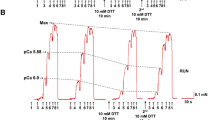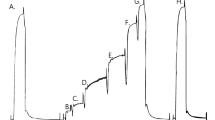Summary
Biopsy samples from the vastus lateralis muscle (VLM) of man were examined for fiber composition at rest and at selected intervals during prolonged exercise ranging in intensity from 40% to 75% of the total body maximal oxygen uptake (VO 2max) and one-min bouts of exercise at 150%VO 2max. Because of the heterogeneity of fibers in human VLM, studies were also completed where the effect of exercise on the fiber composition of the rat soleus muscle (SM) was examined. In some animals the SM from one hindlimb was removed 9 days prior to their being exercised after which the remaining SM was removed. Exercise reduced muscle glycogen in all experiments. In the studies with man, blood lactate exceeded 17 mmoles/l after the heavy exercise but was largely unchanged by endurance exercise. Colonic temperature of the exercised rats exceeded 40° C. In studies where fibers were identified only as type I and type II, type II fibers in the VLM of all samples (16) taken at rest averaged 61.2±12.5% as compared to 59.0±12.0% after exercise (54 biopsy samples). In a second series of studies with man where the subtypes of type II fibers were identified, there were also no differences in fiber composition of the VLM after varying periods of exercise. Glycogen content and percent fiber composition were the same in right and left SM obtained from rested rats. Exercise (30 to 40 min) did not alter the fiber composition of the rat SM. These data demonstrate that the histochemically demonstratable myofibrillar actomyosin ATPase of skeletal muscle is not altered by a single exercise bout.
Similar content being viewed by others
References
Ball ME, Green HJ, Houston ME (1983) Alterations in human muscle fibre type distribution induced by acute exercise. Histochemistry 79:53–57
Bergström J (1962) Muscle electrolytes in man. Scand J Clin Lab Invest 14:Suppl 68
Bergström J, Guarnieri G, Hultman E (1971) Carbohydrate metabolism and electrolyte changes in human muscle tissue during heavy exercise. J Appl Physiol 30:122–125
Costill DL, Saltin B (1975) Muscle glycogen and electrolytes following exercise and thermal dehydration. In: Howald H, Poortmans J (eds) Metabolic adaptations to prolonged exercise. Birkhäuser Verlag, Basel, pp 352–360
Davies KJA, Packer L, Brooks GA (1981) Biochemical adaptations of mitochondria, muscle, and whole-animal respiration to endurance training. Arch Biochem Biophys 209:539–554
Elder GCB, Bradbury K, Roberts R (1982) Variability of fiber type distribution within human muscles. J Appl Physiol 53:1473–1480
Gollnick PD, Armstrong RB, Sembrowich WL, Saltin B (1973a) Glycogen depletion pattern in human skeletal muscle after heavy exercise. J Appl Physiol 34:615–618
Gollnick PD, Armstrong RB, Saubert CW, IV, Sembrowich WL, Shepherd RE, Saltin B (1973b) Glycogen depletion patterns in human skeletal muscle fibers during prolonged work. Pflügers Arch 344:1–12
Gollnick PD, Timson BF, Moore RL, Riedy M (1981) Muscular enlargment and number of fibers in skeletal muscles of rats. J Appl Physiol 50:936–943
Grønnerød O, Dahl H, Vaage O (1977) Easy typing of human muscle fibers in sequentially preincubated myofibrillar. ATPase sections. Proc Int Union Physiol 13:285
Guth L, Samaha FJ (1969) Qualitative differences between actomyosin ATPase of slow and fast mammalian muscle. Exp Neruol 25:138–152
Hermansen L, Osnes JB (1972) Blood and muscle pH after maximal exercise in man. J Appl Physiol 32:304–308
Ianuzzo CD, Chen V (1977) Compensatory hypertrophy of skeletal muscle: contractile characteristics. Physiol Teach 6:4–7
Ianuzzo CD, Gollnick PD, Armstrong RB (1976) Compensatory adaptation of skeletal muscle fiber types to a long-term functional overload. Life Sci 19:1517–1524
Ianuzzo D, Patel P, Chen V, O'Brien P, Williams C (1977) Thyroidal trophic influence on skeletal muscle myosin. Nature 270:74–76
Ianuzzo CD, Chen V (1979) Metabolic character of hypertrophied rat muscle. J Appl Physiol 46:738–742
Lexell J, Henriksson-Larsén K, Sjöström M (1983) Distribution of different fibre types in human skeletal muscle. 2. A study of cross-sections of whole m. vastus lateralis. Acta Physiol Scand 117:115–122
Nihei T, Tonomura Y (1959) Kinetic analysis of the myosin b-adenosine-triphosphatase system. J Biochem (Tokyo) 46:305–319
Parsons D, Riedy M, Moore RL, Gollnick PD (1982) Acute fasting and fiber number in rat soleus. J Appl Physiol 53:1234–1238
Passoneau JV, Lauderdale VR (1974) A comparison of three methods of glycogen measurement in tissues. Anal Biochem 60:405–412
Rovetto MJ, Hjalmarson, Morgan HE, Barrett MJ, Goldstein RA (1972) Hormonal control of cardiac myosin adenosine triphosphatase in the rat. Cir Res 31:397–409
Roy RR, Meadows ID, Baldwin KM, Edgerton VR (1982) Functional significance of compensatory overloaded rat fast muscle. J Appl Physiol 52:473–478
Salhin K, Alvestrand A, Brandt R, Hultman E (1978) Intracellular pH and bicarbonate concentration in human muscle during recovery from exercise. J Appl Physiol 45:474–480
Saltin B, Hermansen L (1966) Esophageal, rectal, and muscle temperature during exercise. J Appl Physiol 21:1757–1762
Saltin B, Gollnick PD (1983) Skeletal muscle adaptability: significance for metabolism and performance. In: Peachy LD, Adrian RH, Geiger SR (eds) Handbook of physiology, Sect. 10: Skeletal muscle. Williams & Wilkins, Baltimore, pp 555–631
Schantz P, Billeter R, Henriksson J, Jansson E (1982) Training-induced increase in myofibrillar ATPase intermediate fibers in human skeletal muscle. Muscle Nerve 5:628–636
Seidel JC (1967) Studies on myosin from red and white skeletal muscle of the rabbit. II. Inactivation of myosin from red muscles under mild alkaline conditions. J Biol Chem 242:5632–5629
Shepherd RE, Gollnick PD (1976) Oxygen uptake of rats at different work intensities. Pflügers Arch 362:219–222
Sreter FA, Seidel JC, Gergely J (1966) Studies on myosin from red and white skeletal muscles of the rabbit. I. Adenosine triphosphatase activity. J Biol Chem 241:5772–5776
Author information
Authors and Affiliations
Rights and permissions
About this article
Cite this article
Riedy, M., Matoba, H., Vøllestad, N.K. et al. Influence of exercise on the fiber composition of skeletal muscle. Histochemistry 80, 553–557 (1984). https://doi.org/10.1007/BF02400971
Accepted:
Issue Date:
DOI: https://doi.org/10.1007/BF02400971




